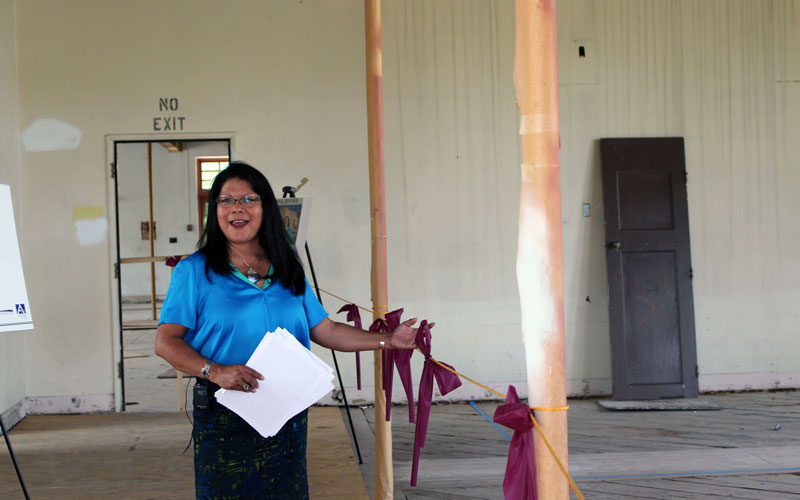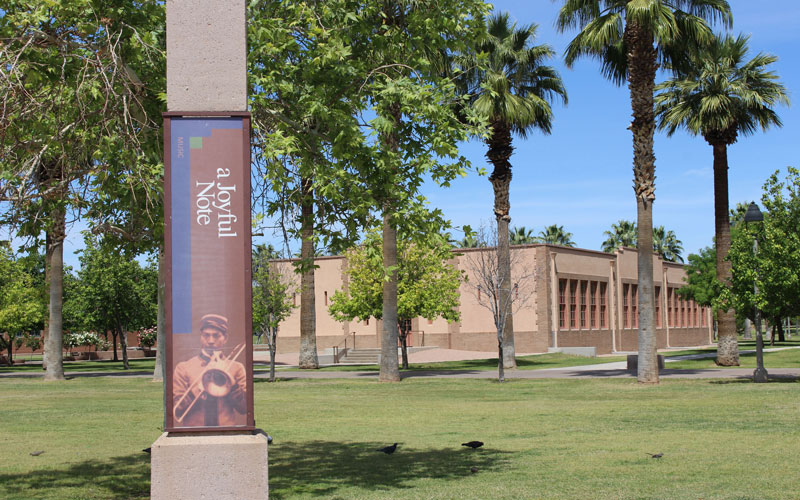
Patty Talahongva, community development manager for Native American Connections, stands in the old band building of Phoenix Indian School, soon to be renovated. (Photo by Clarissa Cooper/Cronkite News)

The old band building of the Phoenix Indian School has been closed for 26 years. Next year, it will reopen as a cultural center. (Photo by Clarissa Cooper/Cronkite News)

A board in the old band building in Steele Indian School Park shows the layout for the renovated cultural center. (Photo by Clarissa Cooper/Cronkite News)
For the past 26 years, the old band building of the Phoenix Indian School stood vacant, a reminder of its legacy as a federal boarding school for Native American children and teens. But later this year, it will be renovated and resurrected as a cultural center to hallmark its history.
The building now is owned by the City of Phoenix, which is paying for a large part of the project. It has partnered with Native American Connections and the Phoenix Indian Center, local organizations focused on Arizona’s native people.
The school opened in 1891 and closed in 1990. The property is now Steele Indian School Park, located near Central Avenue and Indian School Road.
“Native American Connections has been the one who’s taken the lead on opening up the band building,” said Tyre Davis, Park Manager of Steele Indian School Park. “So the city as a partner, we’ve been here, we’ve opened the building up to them and we’ve been working as a collaborative partner so when the funds are intact and ready to go, they’ll be able to operate out of this facility.”
Davis said the city already renovated one of the three remaining school buildings – Memorial Hall – as a concert and meeting venue 15 years ago when the park was developed. The band building and dining hall remained vacant.
“The native community has really not, after 99 years of living here and participating in the boarding school experience here, have not been involved in this property for 25 years,” said Diana Yazzie Devine, president and CEO of Native American Connections. “So we’re very excited about the opportunity to then bring the native community back to the site and to renovate the music building and then to open and operate it as a Native American cultural center.”
The cultural center will have a gallery that depicts the history of the school through its transition from a boarding school to a high school in its later years.
Patty Talahongva, community development manager for Native American Connections, attended the school in the 1970s, when it was a high school. Talahongva’s grandmother was just five years old when she was removed from her home and taken to the boarding school. She did not return to her family until she was 18.
“For those of who have family members who came here when they were five years old and who were raised in a dorm situation, that’s hard reality. It’s a very harsh reality. Those kids were raised without parents,” Talahongva said.
“This became their home, for good or bad. They grew up here.”
Talahongva said the cultural center would bring the school’s community back together. The 6,000-square-foot building, which was built in 1931, will house a commercial kitchen with a classroom to teach people about nutrition and indigenous cooking, a conference room and a business center, in addition to the memorial gallery.
Funding for this project has come from the city, JP Morgan Chase bank, Local Initiatives Support Corporation Phoenix and the Caterpillar Foundation. Native American Connections still is raising money for interior furnishing.
“We’ve been very blessed to be a part of this land and the history of the Native American,” Davis said. “We need to do whatever we can to preserve that history so that everybody else knows … things that took place on this park and how rich and how beautiful the history of the Native American community was to Phoenix and Arizona as a whole.”
Talahongva said she hopes the cultural center will act as a community builder for Arizona’s native tribes and a tool for education for those who do not know about the site’s history. She frequently speaks to schools and groups about the legacy of the Phoenix Indian School.
“Every time I speak to these groups, none of them know the history of Phoenix Indian School. They don’t know the history of the boarding school system in America,” Talahongva said. “So I know already that when we open up this Native American cultural center and business center, and we have our gallery space here, people are going to come in and they’re going to be educated and enlightened.”
“This is a part of our history that we must remember and we must honor.”